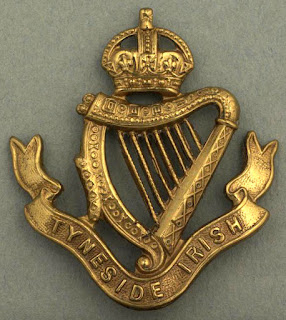Local author John Sheen will be writing a series of blog posts throughout the year following the Tyneside Irish on their journey to the Battle of the Somme and their part in the campaign.
 |
| Tyneside Irish shoulder title, Imperial War Museum IWM Non Commercial Licence © IWM (INS 7625) |
By the end of 1915 the divisions of Kitchener’s Fifth New Army were completing their training in the south of England. These men of the Fifth New Army were formed into the 30th, 31st, 32nd 33rd, 34th and 35th Divisions and mostly contained the famous "PALS" battalions.
Serving in the 34th Division were the Tyneside Irish and the Tyneside Scottish Brigades, which had been recruited as part of the Northumberland Fusiliers throughout the North East during the autumn and winter of 1914.
Whilst these troops were completing their training, in France plans were being made for a large British Offensive against the German Army along the River Somme designed to relieve pressure on the French Army at Verdun.
So it was that 100 years ago this month, the 34th Division mobilized for service in France. Apart from the 50th (Northumbrian) Division that contained the Durham Light Infantry’s territorial battalions, no other formation deployed to France and Flanders contained as many men from County Durham in its ranks. Two of the infantry brigades of 34th Division, as well as the Wearside Brigade of the Royal Field Artillery, had large numbers of Durham men in their ranks. Indeed the 103rd (Tyneside Irish) Brigade recruited over 70% of its soldiers from the towns and villages of County Durham.
Based at Salisbury Plain, Wiltshire, it was a hectic time for all ranks, every man of the brigade had to be medically examined, those considered unfit had to be sent to a reserve battalion and fit replacements absorbed into the ranks. All equipment had to be inspected and checked that it was serviceable with unserviceable equipment being replaced. Equipment reserves needed to be at full strength, if it was stated that the unit should have twenty spare sets of horse shoes or ten additional tents, these had to be indented for and received from the Ordnance depots.
Final parades were held as the Brigade commander and then the General Officer Commanding the 34th Division inspected the battalions.
 |
| The 24th (Service) Battalion, Northumberland Fusiliers (1st Tyneside Irish) ready for an inspection by the General Officer Commanding 34th Division (from the John sheen Collection) |
By 8 January, all battalion advance parties were warned to be ready to go, and the first to leave was the advance party of the 26th Battalion, on 9 January, taking with it all the battalion baggage and transport. The 26th Battalion's main party was next to go, leaving Warminster Station in two trains on the morning of 10 January. They travelled via Folkestone to Boulogne, arriving at 4:00pm and spending the night at St Martin's Camp. As they had crossed the channel their boat passed a hospital ship. Michael Manley recalled, 'We shouted across to them, but they called back "You'll soon change your tune", and they were right.'
Next to leave was the 24th Battalion, leaving in three trains in the early hours of 11 January. The Battalion travelled to Southampton, arriving at 8:30am and rested on the docks until embarking on the SS Mona's Queen at 2:30pm and sailing for Le Havre at 3:30pm. The Isle of Man Steam Packet the Mona’s Queen became famous later in the war when it rammed a German U-boat.
 |
| The Mona's Queen, around 1917 with dazzle camouflage, carried the 1st Tyneside Irish to France in 1916 (from the John sheen Collection) |
The 27th Battalion left at 7:35am going via Folkestone, and arrived in Boulogne by 6:15pm.
Then last but not least, the 25th Battalion were routed via Southampton and starting at 8:40am they travelled in three trains at hourly intervals.
 |
| A horse being hoisted aboard ship, unknown date, The War Illustrated |
They were on their way to the front, and hundreds were never to see Durham again.
___________________________________________
We've been having a few issues with the Durham at War website but we're happy to say a lot of these have now been resolved.
No comments:
Post a Comment